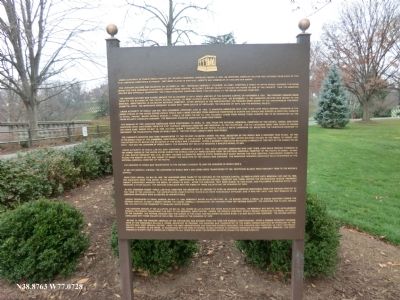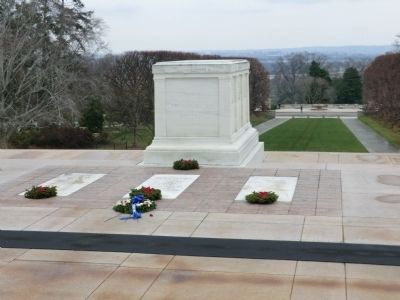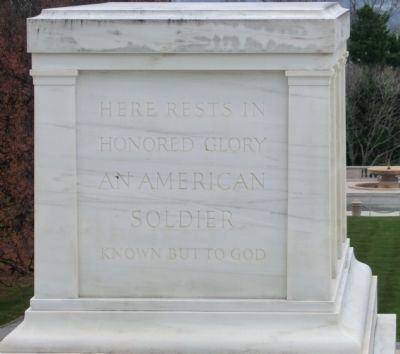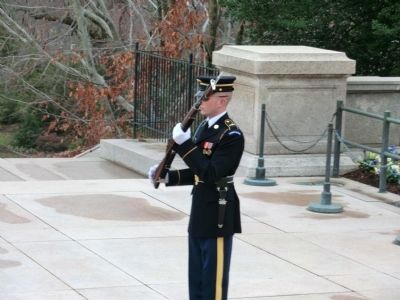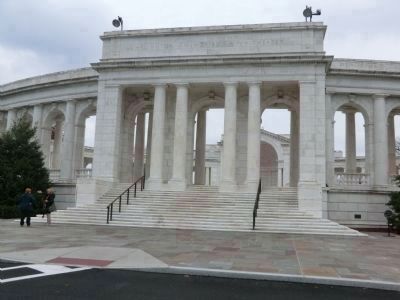Fort Myer in Arlington in Arlington County, Virginia — The American South (Mid-Atlantic)
Tomb of the Unknowns
Under authority of Public Resolution 67, of the 66th Congress, approved March 4, 1921, an unknown American soldier was exhumed from each of the four American cemeteries in France. They were placed in identical caskets and assembled at Chalons Sur Marne.
The Unknown Soldier was selected on October 24, 1921. Sergeant Edward F. Younger, US Army, carrying a spray of white roses, entered the room where the four unmarked flag-draped caskets were resting. He slowly circled, silently placing the roses on one of the caskets. Thus the Unknown Soldier was officially designated. The three remaining unknowns were then returned to the Meuse Argonne Cemetery.
The Unknown Soldier was placed aboard the US Cruiser Olympia, which arrived at the Nation’s Capitol on November 9, 1921. The honored remains were taken to the Rotunda of the United States Capitol, to rest in state until Armistice Day, on November 11. The Unknown Soldier was moved to the Memorial Amphitheater, in Arlington National Cemetery. After service in the Amphitheater, the remains were borne to the sarcophagus for brief committal rites. The impressive ceremony closed with three salvos of artillery, the sounding of Taps, and the National Salute.
Under authority of Public Law 429, 79th Congress approved June 24, 1946, 13 unknown Americans who lost their lives while serving overseas in the Armed Forces of the United States during World War II were exhumed from American cemeteries in Europe and Africa and shipped in identical caskets to Epinal, France. Major General Edward J. O’Neill, US Army, on May 12, 1958, solemnly chose from among these caskets one to be designated as the Trans-Atlantic candidate-unknown. The remaining unknown Americans were reinterred.
The remains of two unknown Americans were disinterred on April 15, 1958, from the National Cemetery of the Pacific, Hawaii, and four unknowns were disinterred from the Fort McKinley American Cemetery and Memorial, in the Philippines. The six unknowns were then taken to Hickam Air Force Base, where on May 16, 1958, Colonel Glenn T. Eagleston, US Air Force, placed a white carnation lei, selecting the candidate-unknown to represent the Trans-Pacific phase of World War II. The five other caskets were reinterred.
The candidate-unknown was then transported to the Cruiser Canberra where the final selection of the World War II unknown took place. On the after-missile deck of the Canberra, Hospitalman First Class William R. Charette, the Navy’s only active enlisted holder of the Medal of Honor, had the distinction of making the selection of the World War II unknown. After a moment's hesitation he placed a wreath at the foot of the casket on his right. This was the unknown of World War II. The unknown not selected received a sailor’s burial at sea.
Under authority of Public Law 972, 84th Congress, approved August 3, 1958, four unknown Americans who lost their lives while serving overseas in the Armed Forces of the United States during the Korean Conflict were exhumed from the National Memorial Cemetery of the Pacific in Hawaii. On May 15, 1958, Master Sergeant Ned Lyle, US Army, holding a carnation wreath stood momentarily silent before the four identical flag-draped caskets; he placed the wreath on the end casket to signify the selection of the Korean War unknown. The remaining unknown Americans were reinterred at the National Memorial Cemetery of the Pacific.
The unknown of Korea was transported to the Cruiser Canberra to join the unknown of World War II.
At sea off Norfolk, Virginia, the unknown of World War II and Korea were transferred to the destroyer Blandy, which brought them to the Nation’s Capitol.
Upon their arrival, on May 28, 1958, the Unknowns were taken to the Rotunda of the Nation’s Capitol, to rest in state until Memorial Day, May 30, 1958. The Unknowns were then moved to the Memorial Amphitheater in Arlington National Cemetery and there, before the distinguished guests, President Dwight Eisenhower awarded the Medal of Honor to each. After
the service, they were borne to this plaza, and following religious rites, they received a 21-gun salute. The service concluded with the firing of three volleys and the sounding of Taps.
In 1973, Congress passed Public Law 93-43, directing the Secretary of Defense to inter an unknown American serviceman from the Vietnam Conflict at the Tomb of the Unknowns. The sophisticated identification techniques were remarkably efficient, and it was not until 1984 that remains of an American serviceman were classified as unidentifiable.
During ceremonies at Pearl Harbor, on May 17, 1984, Sergeant Major Allan Kellogg, Jr., US Marine Corps, a Medal of Honor recipient during the Vietnam Conflict, placed a wreath before the casket, formally designating the unknown from the Vietnam Conflict. The unknown was placed aboard the USS Brewton for transport to mainland United States.
The unknown arrived at the US Capitol on May 25, 1984, where he lay in state for three days in the Rotunda. On Memorial Day, May 28, 1984, and elaborate funeral procession transferred the body to the Memorial Amphitheater. During the service, President Ronald Reagan presented the Medal of Honor to the unknown. The Vietnam unknown was then borne to the plaza, and following religious rites, a 21-gun salute was rendered. The solemn service concluded with three volleys of rifle fire, followed by the sounding of Taps.
On May 14, 1998, the unknown American of the Vietnam era was exhumed from the tomb for possible identification. After a somber ceremony presided over by the Honorable William S. Cohen, Secretary of Defense, the unknown was transported to the Armed Forces Institute of Pathology at the Walter Reed Army Medical Center. Using the most sophisticated and exacting science available, the unknown was identified as First Lieutenant Michael J. Blassie, US Air Force. In accordance with his family’s wishes, he was interred in Jefferson Barracks National Cemetery, Missouri. The crypt presently is empty, but it serves as a tribute to all those who made the supreme sacrifice during the Vietnam Conflict.
Topics and series. This memorial is listed in these topic lists: Cemeteries & Burial Sites • Military. In addition, it is included in the Former U.S. Presidents: #34 Dwight D. Eisenhower, the Former U.S. Presidents: #40 Ronald Reagan, the Medal of Honor Recipients, and the National Cemeteries series lists. A significant historical date for this entry is March 4, 1921.
Location. 38° 52.568′ N, 77° 4.342′ W. Marker is in Arlington, Virginia, in Arlington County. It is in Fort Myer. Memorial can be reached from Memorial Drive north of Porter Drive, on the right when traveling north. Located at
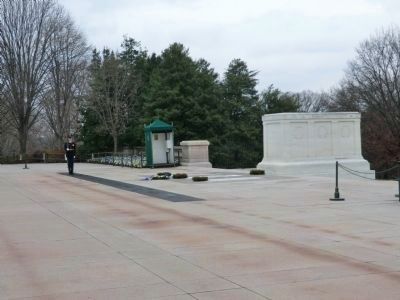
Photographed By Don Morfe, December 16, 2012
5. Tomb of the Unknowns
The Tomb Guard marches 21 steps down the black mat behind the Tomb, turns, faces east for 21 seconds, turns and faces north for 21 seconds, then takes 21 steps down the mat and repeats the process. After the turn, the sentinel executes a sharp "shoulder-arms" movement to place the weapon on the shoulder closest to the visitors to signify that the sentinel stands between the Tomb and any possible threat. Twenty-one was chosen because it symbolizes the highest military honor that can be bestowed -- the 21-gun salute.
Other nearby markers. At least 8 other markers are within walking distance of this marker. General George C. Marshall (here, next to this marker); 508 Parachute Infantry Regiment (within shouting distance of this marker); United States Army 8th Air Force (within shouting distance of this marker); 416th Bombardment Group (within shouting distance of this marker); 3d United States Infantry (within shouting distance of this marker); The Memorial Carillon at Arlington National Cemetery (within shouting distance of this marker); Seafarers Memorial (about 300 feet away, measured in a direct line); Pearl Harbor Survivors Association (about 300 feet away). Touch for a list and map of all markers in Arlington.
Also see . . .
1. Society of the Honor Guard, Tomb of the Unknown. Detailed stories of the Unknowns. (Submitted on December 19, 2012.)
2. Wikipedia Entry. “The Sentinel—the soldier ‘walking the mat’—does not wear rank insignia, so as not to outrank the Unknowns, whatever their ranks may have been. Non-commissioned officers (usually the Relief Commander and Assistant Relief Commanders), do wear insignia of their rank when changing the guard only. They have a separate uniform
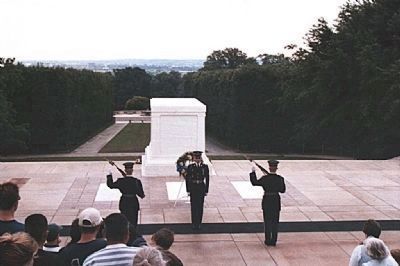
Photographed By Mike Stroud, June 1, 1999
6. Tomb of the Unknowns, changing of the guard
The guard is changed every hour on the hour Oct. 1 to March 31 in an elaborate ritual. From April 1 through September 30, there are more than double the opportunities to view the change because another change is added on the half hour and the cemetery closing time moves from 5 to 7 p.m.
“A civilian guard was first posted at the Tomb on November 17, 1925, to prevent, among other things, families from picnicking on the flat marble slab with views of the city. A military guard was first posted on March 25, 1926. The first 24-hour guard was posted on midnight, July 2, 1937. The Tomb of the Unknowns has been guarded continuously, 24 hours a day, 7 days a week, since that time. Inclement weather, terrorist attacks, et cetera, do not cause the watch to cease.” (Submitted on October 21, 2017.)
Credits. This page was last revised on February 1, 2023. It was originally submitted on December 17, 2012, by Don Morfe of Baltimore, Maryland. This page has been viewed 870 times since then and 25 times this year. It was the Marker of the Week October 22, 2017. Photos: 1, 2, 3, 4, 5. submitted on December 17, 2012, by Don Morfe of Baltimore, Maryland. 6. submitted on December 19, 2012, by Mike Stroud of Bluffton, South Carolina. 7. submitted on December 17, 2012, by Don Morfe of Baltimore, Maryland. • Bernard Fisher was the editor who published this page.
